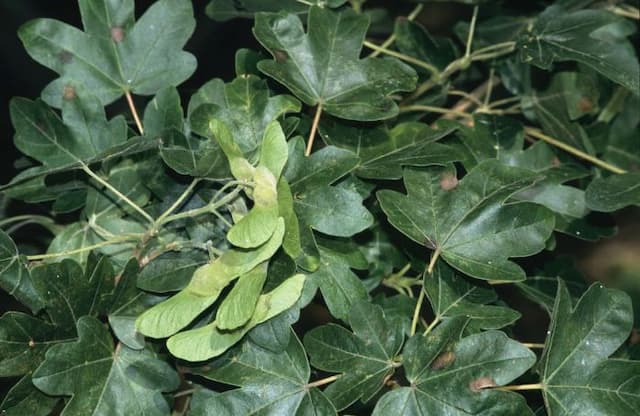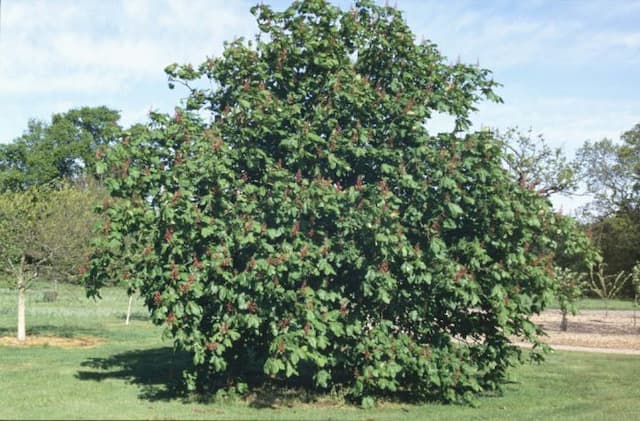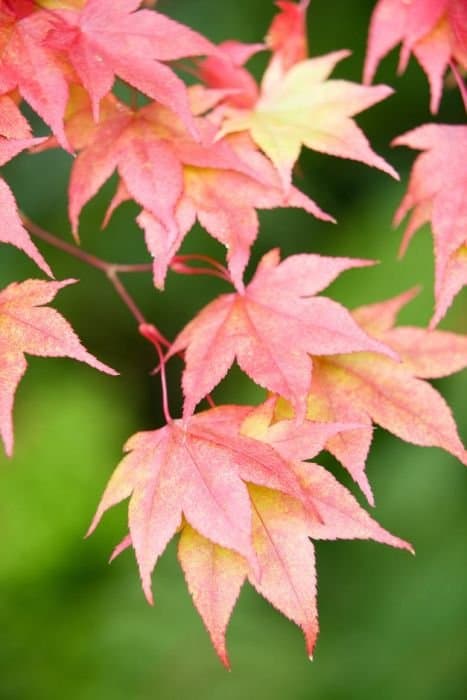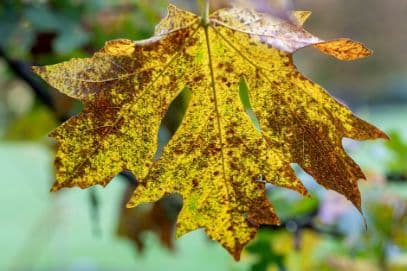Père David's maple Acer davidii 'Ernest Wilson'

ABOUT
Acer davidii 'Ernest Wilson', commonly known as the snakebark maple, is a visually striking variety of maple tree known for its distinctive bark and attractive foliage. The bark is particularly notable with irregular green and white striations giving it a snakeskin-like appearance, hence the name snakebark. The stripes often become more pronounced as the tree matures, which adds to its ornamental appeal throughout the year. The leaves of the snakebark maple have a classic maple shape, with three or five lobes and serrated edges. During spring and summer, the foliage is a fresh green color, offering a soft and lush canopy. As the seasons change, the tree showcases a vibrant transformation with leaves turning to bright shades of red, orange, and yellow in autumn, creating a breathtaking display of fall color. Small yellow flowers may bloom in spring, though they are not particularly showy. These are followed by the development of samaras, which are winged fruits typical of maples. The samaras' paired wings help in the dispersal of seeds by the wind. The tree's overall appearance—with its attractive bark, elegant leaves, and seasonal color changes—makes it a favorite for gardeners looking to add year-round interest to their landscapes.
About this plant
 Names
NamesSynonyms
David's Maple, Pere David's Maple, Ernest Wilson's Maple
Common names
Acer davidii 'Ernest Wilson'.
 Toxicity
ToxicityTo humans
The Acer davidii 'Ernest Wilson', commonly known as the David maple, is not widely recognized as a poisonous plant to humans. There is no significant data that suggests the ingestion of parts of this plant would lead to poisoning or toxic reactions in humans. However, as with many plants, individual allergies or sensitivities could potentially cause mild stomach upset or dermatological reactions in some individuals if they were to come into contact with or ingest parts of the plant.
To pets
The David maple, or Acer davidii 'Ernest Wilson', is not known to be toxic to pets. It does not appear on common lists of plants that are poisonous to domestic animals such as cats and dogs. Ingestion of plant material, including leaves or seeds, is unlikely to cause serious harm, but as with any non-food plant, it is possible for pets to experience mild gastrointestinal upset if they consume large amounts of the plant material. It is always advisable to monitor pets around plants and discourage them from chewing on plants that are not intended for consumption.
 Characteristics
CharacteristicsLife cycle
Perennials
Foliage type
Deciduous
Color of leaves
Green
Flower color
Yellow
Height
20-25 feet (6-7.5 meters)
Spread
15-25 feet (4.5-7.5 meters)
Plant type
Tree
Hardiness zones
6
Native area
China
Benefits
 General Benefits
General Benefits- Aesthetic Appeal: This plant has attractive bark and foliage that enhances the visual interest in a landscape.
- Seasonal Interest: It offers year-round interest with its striking bark in the winter and colorful leaves in the autumn.
- Wildlife Attraction: The tree can attract birds and other wildlife, providing a habitat and food resources.
- Shade Provision: As a medium-sized tree, it can provide shade in gardens and parks, creating a cool area during hot days.
- Low Maintenance: Once established, it requires minimal pruning and care compared to many other ornamental trees.
- Drought Tolerance: It is relatively tolerant of drought, making it suitable for a variety of landscapes, including those with drier climates.
- Tolerant of Different Soil Types: The tree is adaptable to a range of soil conditions, increasing its versatility in landscaping.
- Erosion Control: Its root system can help to stabilize the soil, reducing erosion on slopes.
- Cold Hardy: It is capable of withstanding cold temperatures, making it suitable for cooler climates.
 Medical Properties
Medical PropertiesThis plant is not used for medical purposes.
 Air-purifying Qualities
Air-purifying QualitiesThis plant is not specifically known for air purifying qualities.
 Other Uses
Other Uses- Acer davidii 'Ernest Wilson', commonly known as the David Maple, can be used as an educational tool in botany and horticulture classes to illustrate the characteristics of the Aceraceae family.
- The distinct striped bark of David Maple makes it an excellent candidate for casting in garden art projects, where textures from nature are used to create unique sculptures or relief artworks.
- The wood of David Maple can be harvested and utilized in the crafting of small wooden objects, such as picture frames, owing to its fine grain and workability.
- This tree's bark and leaves can serve as a natural dye source for textiles, yielding colors that range from green to brown depending on the mordant used.
- David Maple can be integrated into landscape photography classes as a subject to teach the art of capturing seasonal changes, as it provides vibrant foliage throughout the year.
- When pruned properly, branches from the David Maple can be fashioned into rustic handrails or balustrades for use in garden landscaping.
- The fallen leaves of the David Maple can be collected and used in composting, contributing to a nutrient-rich compost that benefits garden soils.
- With its striking appearance, the David Maple can be planted as a focal point in psychological therapy gardens to help create a calm and tranquil environment.
- The tree can be used in urban planning and architecture as a natural measure to provide shade and reduce the heat island effect in cities.
- Its seeds, known as samaras, can be used in crafts and educational projects to illustrate the concept of wind dispersal in plants.
Interesting Facts
 Feng Shui
Feng ShuiThe Snakebark Maple is not used in Feng Shui practice.
 Zodiac Sign Compitability
Zodiac Sign CompitabilityThe Snakebark Maple is not used in astrology practice.
 Plant Symbolism
Plant Symbolism- Resilience: As a hardy species, the Snakebark Maple stands as a symbol of the ability to withstand diverse and challenging conditions.
- Adaptability: Its capability to grow in various climates and conditions represents flexibility and the willingness to adjust to different situations in life.
- Growth: Like many trees, this species exemplifies growth, both physical and personal, encouraging individuals to aim for continuous improvement and development.
- Unique Beauty: The distinctive striped bark of the Snakebark Maple reflects the idea of embracing one's unique features and the beauty that comes from standing out.
- Endurance: A long-lived species, the Snakebark Maple symbolizes the endurance over time and persistence through life's trials.
 Water
WaterThe Père David's maple should be watered deeply and allowed to dry out slightly between waterings. Typically, this means watering the plant once a week with about 2 gallons of water, although this can vary depending on weather conditions and soil type. During the growing season in spring and summer, you might need to water more frequently, especially if the weather is hot and dry. Conversely, reduce watering in the fall and water sparingly in winter when the tree is dormant. Always adjust your watering schedule based on the moisture level of the soil at a depth of several inches.
 Light
LightPère David's maple thrives in partial to full sunlight. The best spot for this tree would be a location where it can receive at least four hours of direct sunlight a day, with some protection from the harsh afternoon sun, especially in hotter climates. Dappled sunlight conditions are ideal as it mimics the maple's natural woodland habitat.
 Temperature
TemperaturePère David's maple prefers a temperate climate with temperatures ranging from about 20°F in the winter to 80°F in the summer. While it can endure short periods of colder weather down to around -10°F, prolonged exposure to such low temperatures can be damaging. Ideally, the plant should be in a region where the average temperature remains within the stated range throughout the majority of the year.
 Pruning
PruningPrune Père David's maple to maintain its shape and remove any dead or damaged branches. The best time to prune is during the dormant season, in late winter or early spring before new growth starts. Pruning every year or two is sufficient to keep the tree healthy and control its size.
 Cleaning
CleaningAs needed
 Soil
SoilThe best soil mix for the Père David's maple (Acer davidii 'Ernest Wilson') is one that is well-draining and fertile, with a mix of loam, peat, and sharp sand. The soil pH should be slightly acidic to neutral, ideally between 5.5 and 7.0.
 Repotting
RepottingPère David's maple does not often require repotting as it is typically grown as an outdoor tree. However, if grown in a container, young trees may need repotting every 2-3 years to accommodate root growth.
 Humidity & Misting
Humidity & MistingPère David's maple is tolerant of a wide range of humidity levels but prefers average to high humidity. As a tree naturally growing in forested areas, it can adapt to the local humidity conditions.
 Suitable locations
Suitable locationsIndoor
Provide bright, indirect light and ensure soil is well-draining.
Outdoor
Plant in partial shade, shelter from strong winds, in fertile soil.
Hardiness zone
6-8 USDA
 Life cycle
Life cycleAcer davidii 'Ernest Wilson', commonly known as David maple, begins its life cycle as a seed which germinates in the spring after a period of cold stratification. The seedling quickly forms a taproot and begins to grow upward, developing into a young sapling with a characteristic green-striped bark. As the sapling matures into an adult tree over several years, it establishes a broad canopy of heart-shaped leaves, which turn vibrant colors in the fall. The tree reaches reproductive maturity and starts to produce small, yellowish flowers which are pollinated by wind, leading to the production of winged samaras, commonly known as "helicopter seeds" or "maple keys." These seeds are dispersed by wind and, if they land in suitable conditions, will germinate to start a new life cycle. The David maple can live for many decades, during which time it may experience cycles of growth, flowering, and seed production.
 Propogation
PropogationPropogation time
Spring-Early Summer
Acer davidii 'Ernest Wilson', commonly known as Ernest Wilson's Maple, is most commonly propagated by seed. The best time to sow the seeds is in autumn, immediately after collection, as this aligns with the natural cycle of the tree and maximizes the chances of successful germination. The seeds require stratification, a process of cold treatment to break dormancy. This can be achieved naturally by sowing them outdoors in the fall, allowing the cold winter temperatures to stratify the seeds. Alternatively, stratification can be done artificially by placing the seeds in moist sand or a mixture of peat and sand within a sealed bag, and then refrigerating them at around 34 to 41 degrees Fahrenheit (1 to 5 degrees Celsius) for approximately 90 to 120 days before sowing in the spring. Once the stratification process is complete, seeds can be sown in a well-draining soil mix, lightly covered with soil, and kept moist until germination occurs. Seedlings can then be grown on in containers before eventually being planted out into their permanent positions.








